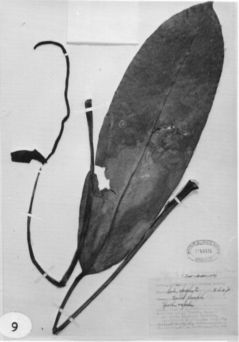




Publ. Field Mus. Nat. Hist., Bot. Ser. 22:67.1940. TYPE: Panama. Chiriquí: Bajo Chorro, Boquete Dist., 1,800 m, Davidson 283 (F, holotype; MO 1154936, isotype).
LEAVES with petioles 20-33 cm long, ca. 5 mm diam., subterete weakly sulcate; blades oblong-elliptic, 29-39 cm long, 7-12 cm wide, broadest at middle, abruptly to gradually acuminate at apex, obtuse at base, sparsely glandular-punctate on both surfaces; midrib sharply raised above, moderately flat below; primary lateral veins 10-12 per side, departing midrib at 45° angle; sub-marginal collective vein arising from base, prominulous on drying, scarcely more prominent than the interprimary veins, 5-9 mm from margin.
INFLORESCENCE as long or longer than leaves; peduncle 27-41 cm long, 3-5 mm diam., terete, longer than petioles; spathe purplish, oblanceolate, 6.5-8 cm long, 1-1.5 cm wide; inserted at ca. 30° angle on peduncle; spadix stipitate, 1.5-1.7 cm long, slightly tapered toward apex, purple to reddish brown, 12-25 cm long, 4-7 mm diam.; flowers rhombic, 2.5-4 mm long, 3-5 flowers visible in the principal spiral; stamens weakly exserted (?), anthers 0.6 mm wide; thecae ovate; staminal progression not known.
INFRUCTESCENCE not seen. Fig. 9.
Anthurium chiriquense is endemic to Panama in Chiriquí Province at 1,900 to 2,000 m. Until recently the species had been collected only twice at Bajo Chorro (NW of Boquete) about 40 years ago.
The species is distinguished by its epiphytic habit, its slender stem with coarse, persistent, straw-colored cataphyll fibers, its long petioles nearly equalling the blade, its large oblong-elliptic, glandular-punctate blades that are stoutly three-veined and obtuse at the base with the collective vein 5-10 mm from the margin, and by its long-pedunculate inflorescence with a long-stipitate, slender, reddish to purplish spadix.
Standley states in the type description that the species is epunctate (which isn't true) and that it is related to A. turrialbense (now a synonym of A, bakeri), to which it is only distantly related. Both are members of section Porphyrochitonium.
Anthurium chiriquense is most closely related to A. circinatum from Cerro Colorado, and perhaps that species will prove to be separated from it at only the subspecific level. Anthurium circinatum differs in having more coriaceous blades that are usually round at the base, drying weakly glossy on the lower surface, and has a spadix that becomes spiralled as it matures. Anthurium chiriquense, on the other hand, has thinner blades that are acute at the base, drying matte on the lower surface and has spadices that do not show evidence of coiling in age.

Map of Mesoamerican specimens with coordinates
Panama Chiriquí: Fortuna Dam Area, 1300 m, 8.43N 82.14W, 24 Feb 1985,
Hampshire & Whiteford 54 (BM).